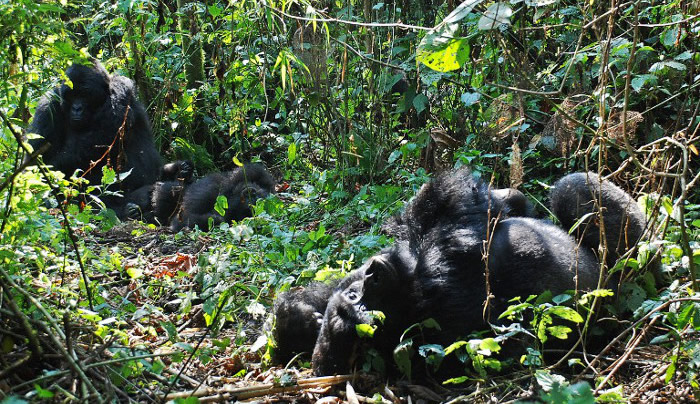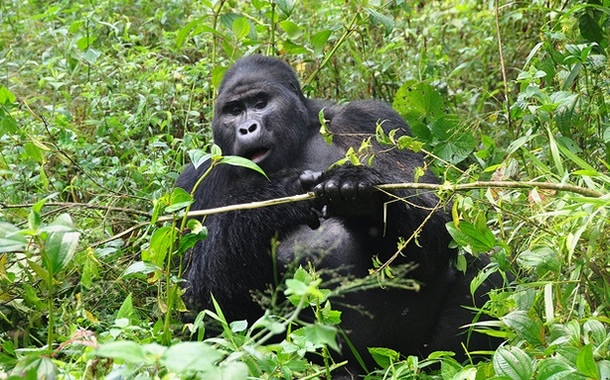Chimps & Other Primates Tours in Rwanda
Chimpanzee trekking in Rwanda is done in Nyungwe National park located in the southwestern part of Rwanda bordered by Burundi in the south and Lake Kivu and the Democratic Republic of Congo to the west.
Nyungwe National park covers an area of 970 square kilometres with a rain forest, bamboo, grassland and swamps kind of vegetation which inhabits 13 primate species including over 400 chimpanzees, L’Hoest’s monkeys, colubus monkeys, velvet monkeys, grey-cheeked mangabey, olive baboon, silver monkeys among others.
Nyungwe National park can be accessed from Kigali-Nyanza-Huye then finally to Nyungwe, the distance may take 5-6 hours drive. It can also be accessed by air to Kanombe airport using the services of Akagera aviation.
Where chimpanzee trekking is done in Nyungwe National park?
Chimpanzee tracking in Nyungwe National park is carried out in Cyamudongo area and others in Uwinka area of Nyungwe forest and all with about 400 chimpanzees.
- Cyamudongo forest
Cyamudongo forest is a small forest with only 19 square kilometres but the best home for chimpanzee trekking than any other part in Nyungwe forest. It was connected to Nyungwe forest but after it was destroyed and became isolated but still part of Nyungwe.
Cyamudongo forest is home to a big group of chimpanzees and many other primates like L’Hoest’s monkeys, Rwenzori colubus monkeys, velvet monkeys, several bird species, butterfly species and many endemic species of flora and fauna. It is also unique for other plant species like Orchid blue chertiae which is not found elsewhere in Nyungwe.
Chimpanzee trekking can also be done around Uwinka area because there is a group near Uwinka reception centre with over 40 individuals in the group and quite difficult to trek.
Other places to see Chimpanzees in Rwanda
Besides Nyungwe National park being the well-known destination for chimpanzee trekking in Rwanda, chimpanzees can also be viewed and trekked from Gishwati Mukura National park, the newest Rwanda tour destination located in the western side of the country. Gishwati Mukuru National park is home to several habituated chimpanzees just in case one misses permits for Nyungwe National park.
Chimpanzee tracking experience
Chimpanzee tracking is an exciting experience that involves travellers to move through the forests in search of the habituated chimpanzees in their natural habitats. Chimpanzees are popular primates that attract tourists to Rwanda just like the Gorillas in Volcanoes National park in northwestern Rwanda.
Chimpanzee trekking is a park activity that involves following trails after early morning briefing by the ranger guides on the dos and don’ts of chimpanzee trekking. Follow trails with the rangers as you head to the forests in search for the chimpanzee in their natural environment, on the encounter with the chimpanzees, you are required to view the chimpanzees, watch their behaviours, feeding, take pictures and videos in only one hour and vacate the forest. This marks the breathtaking and unforgettable memorial experience for the visitors.
When to go chimps trekking?
Chimpanzees are normally seen early in the morning meaning you have to wake up early in the morning by 6:30 visitors should be at the park headquarters.
Chimpanzee trekking in Rwanda can also be done in the months of January, February, June, July, August, September and December because these are dry months, also known as the peak season. They experience little or no rainfall making the trekking areas less slippery and reachable during the trekking time.
Rwanda Chimpanzee trekking fees
Foreign non-residents pay 90 US dollars
Foreign residents pay 60 US dollars
Rwandans pay 5000 Rwf
Students who are foreign residents pay 30 US dollars
Rwandan students who are citizens pay 2500 Rwf
East Africa community foreign residents pay 60 US dollars
Nationals from the East African community pay 10 US dollars
East Africa community students pay 5 US dollars
Chimpanzee trekking rules and regulations
Keep a distance of 8 meters from the presence of chimpanzees, however much habituated they are, chimpanzees are wild animals and can be dangerous when you come close to them.
Trekkers above the age of 15 years are allowed to trek the chimpanzees because young people normally have infectious diseases that can be transferred to chimpanzees.
Do not trek chimpanzees when you have a cold or cough because the chimpanzees easily get affected.
Do not eat and drink while with the chimpanzees.
The visitors should keep their voices low when trekking chimpanzees because the noise scares them away and other wild animals and miss a chance of encountering with them.
Chimpanzee trekking only allows a maximum of 6 members per chimpanzee group every day.
Do not use flash cameras while taking pictures and videos because they destruct the chimpanzees making them charge.
Do not litter rubbish and leftovers in the forests which makes the chimpanzees sick.
What to carry for chimpanzee trekking?
Some of the elements required when going for chimpanzee trekking include;
- Trousers and long-sleeved shirts/blouses
Wear the long-sleeved shirt to protect you from the strong shrubs as you move through the forest in search of the chimpanzees.
- Hiking boots
Help to ease the movement of trekkers especially in the muddy and slippery areas.
- Rain jacket
Travellers are always advised to carry a rain jacket going to trek chimpanzees just in case of rain.
Garden gloves help to protect you from the harsh trees and insect bites as you hike through the hard trails.
Wear a hut to protect you from the direct sun and in case of rain.
Carry cameras to take pictures and videos of the chimpanzees in their natural inhabits.
Carry extra lenses and batteries in case the batteries of the camera are finished to continue taking the memorable pictures with chimpanzees.
Other things to do in Nyungwe National Park
Besides chimps tracking, Nyungwe national park has more to offer to tourists, and these include;
- Birding:
The park has over 300 bird species and among the frequently spotted species include White-tailed Crested Flycatcher, Rwenzori Nightjar, the Handsome Francolin, Kivu Ground Thrush, Great blue and Rwenzori Turaco, Dwarf Honeyguide, the Red- Throated Alethe, and montane Double Collared Sun.
- Canopy walk:
This was introduced in 2010, and its the only one we have in East Africa! It is a 90 meters long walk on top of Nyungwe Jungle, extremely interesting and rewards you with a face to face interaction with many bird species, primates and butterflies. To take part in the Canopy walk adventure, you are required to pay US$60 for foreign non-residents!
- Black and White Colobus monkey tracking:
Nyungwe National Park has large troops of Black and white colobus monkeys, ranging between 400 and 600 individuals. It’s another amazing experience in Nyungwe Jungle! To take part in colobus monkey tracking, you are required to pay US$60 for foreign non-residents!
- Guided Forest walk:
There are many hiking trails in Nyungwe National park. Choose one in your ability to hike! Some of them include Isumo Waterfall Trail, Bigugu Trail, Ngabwe Trail, Kamiranzovu Marsh Trail, and Igishigishigi Trail among others.
- Community Tours:
Tourist can visit local communities surrounding Nyungwe National Park, visit them in their fields, homesteads or coffee plantations. You can take part in local activities such as milking cows, harvesting coffee and digging among others.


